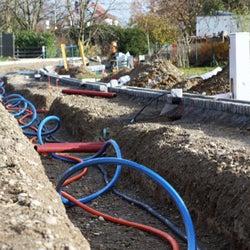Fibre broadband has many benefits: its high speeds mean you can do more in a shorter amount of time; the connections are more reliable and consistent; and fibre gives you dedicated capacity, which means everyone at your place can watch, play, listen, or work all at once. But, if you have never had fibre connected at your house before, there are a few simple steps you will have to go through to get an installation of fibre, also known as ultra-fast broadband.
The steps for getting fibre installed
1. Make sure fibre is in your street

You may be getting excited if fibre is coming to your town, but you will not be able to connect until installations have been finished for your area. Your provider should be able to tell you if fibre is available at your house. New Zealand’s largest telecommunications infrastructure company, Chorus – formerly part of Telecom, also has an online checker of fibre availability for your address. Chorus has connected more than 500,000 homes and businesses to its fibre network.
2. Pick a provider
With help from Canstar Blue, picking a provider that is right for you is the easy step. You can see below for more information on the best plans for those new to fibre, or compare broadband providers now.
Once you have chosen a provider, you will need to order fibre.
3. Get consents for fibre
If you are renting or leasing, if you live in a house with a shared driveway or right-of-way, of if you live in an apartment block, consent will be needed from the property owner and any neighbours who share the land that the fibre cable will have to cross. This can add some delay to the process, especially if there are a lot of people to get hold of.
In most cases, the local fibre company will organise the consent process but, in some cases, you will be expected to approach your landlord for permission. Ask your provider who will get the consent, so there is minimal delay with this process.
4. Wait for a technician

A technician from your local fibre company will need to come around to your house to install the fibre connection. Your local fibre company depends on where you live, not which provider you have chosen.
- The major fibre companies are Chorus – covering greater Auckland, Waiuku, Palmerston North, Feilding, Wellington and Dunedin;
- Enable – covering Christchurch and Rangiora;
- Ultra Fast Fibre – covering Hamilton, Tokoroa, Cambridge and Te Awamutu;
- and NorthPower in Whangarei.
In most cases, a technician will come around to your house for scoping – to see what work needs to be done and where things should go. You will need to be at home for this visit, to discuss the best options for the install.
The physical installation involves two parts. Firstly, it involves connecting the fibre from the street to the outside of your house and will involve installing a new small box called an exterior terminal point. Secondly, the fibre cable will be brought into your home, where it connects with a larger box – an optical network terminal or ONT.
How long does it take to get fibre installed?
While fibre broadband maybe ultra-fast, it is not a speedy process to get connections, unfortunately, with some connections taking up to three months to get sorted. Local fibre companies are speeding up their connections, with Chorus completing 50 per cent of installations within a day – so there are not multiple visits over a series of days.
If you cannot wait for that long without internet connection, see what your provider will offer you as a back-up until fibre is installed.
What are the best plans for those new to fibre?
The best plans for those new to fibre are affordable and flexible, while keeping installation costs to a minimum. With each provider, you’ll need to pay more if you want faster speeds for your fibre. Here’s some of best plans for those wanting ultra-good, ultra-fast broadband:
Skinny Broadband
Canstar Blue’s top 2018 provider, Skinny has a range of affordable fibre plans:
- Unlimited Fibre 30 – $73 per month. Fibre speeds of 30/10Mbps
- Unlimited Fibre 100 – $78 per month. Fibre speeds of 100/20Mbps
- Unlimited Fibre 200 – $88 per month. Fibre speeds of 200/20Mbps
- Unlimited Fibre Ultra – $98 per month. Fibre speeds of 900/500Mbps
Customers can either sign up for 12 months, or pay $49 for a standard connection fee and $99 for a Skinny modem.
MyRupublic
MyRepublic offers two unlimited fibre deals:
- Fibre 100 (speeds up to 100/20Mbps) – $74.99 per month
- Ultra-Fast Fibre Pro (speeds up to 950/500Mbps) – $99 per month
These plans are also on a 12-month contract and include a free modem. However, if you don’t want to be locked into a contract, MyRepublic’s ‘Flexi Plan’ costs $5 a month more on the Fibre 100 plan (same monthly price on the Fibre Pro plan) and you will have to pay $99.99 for a modem.
Slingshot Broadband
Slingshot offers two unlimited fibre plans:
- Unlimited (speeds up to 100/20Mbps) – $84.95 per month
- Unlimited Gigantic (speeds up to 900/450Mbps) – $99.95 per month
You can choose if you want these plans on a 12-month or 24-month contracts, and free modem rental is provided (you must pay 14.95 postage and packaging). Slingshot also has a range of mobile phone plans, as well as power, giving further discounts.
Orcon
Orcon provides two different fibre plans:
- Fibre 100 (speeds of up to 100/20Mbps) – $84.95 per month
- Gigantic Fibre (speeds of up to 900/450Mbps) – $99.95 per month
The plans are for 12 months and include free modem rental (you pay $14.95 p&p). Orcon also provides incentives for bundling your power in with broadband, and offers mobile plans so you can have all your utilities on the one monthly bill.
2 Degrees Broadband
2 Degrees offers three fibre plans:
- 80GB (speeds up to 100/20Mbps) – $75 per month
- Unlimited (speeds up to 100/20Mbps) – $85 per month
- Ultimate unlimited (speeds up to 900Mbps) – $110 per month
2 Degrees offers free connection and modem rental (you pay $15 p&p) for those who sign-up for 12 months, or charges a $99 connection fee and $165 for a modem for those on an open-term plan. 2 Degrees mobile customers also receive $10 off their plan each month.
Stuff Fibre
Stuff Fibre only offers fibre. Its two plans are:
- Unlimited (speeds up to 100/20Mbps) – $89.50 per month
- Unlimited boost (speeds up to 950/500Mbps) – $109.50 per month
The plan comes with a Gigabit Router for no additional costs or set-up fees, but you can upgrade to a high-end, fast-speed router for an extra $299. These prices are available on an open plan, or you can get a $10 “loyalty discount” each month if you commit to 12 months or more.
Vodafone Broadband
Vodafone offers a number of different fibre broadband packages. Although it is on the more expensive side, here are its best plans:
- 240GB (speeds up to 100Mbps) – $69.99 per month
- Unlimited (speeds of up to 100Mbps) – $79.99 per month
- Unlimited (speeds up to 200Mbps) – $99.99 per month
- Unlimited Fibre Max (speeds up to 700–900Mbps) – $109.99 per month
These plans are all for a 24-month contract, including free standard install and modem (you pay $14.95 p&p). Vodafone also has other options, such as plans with Vodafone TV Intro for an extra $15 per month on a 12-month contract, or a $10 a month discount with an eligible on-account Vodafone mobile phone.
Spark Broadband
Spark offers a range of fibre plans, each based around its unplan, where costs move depending on how much data you use each month. In summary, its fibre plans are:
- Unplan Fibre Basic (speeds of up to 50/10Mbps) – $65-85 per month
- Unplan Fibre 100 (speeds up to 100/20Mbps) – $75-95 per month
- Unplan Fibre 200 (speeds up to 200/20Mbps) – $90-110 per month
- Unplan Fibre Max (speeds up to 900/400Mbps) – $110-130 per month
These plans are all for 12 months, including free standard installation and modem (you pay $14.95 p&p). There is also the option of paying $10 extra each month for an entertainment package, which includes Netflix for six Months and Lightbox Standard Plan.


Share this article